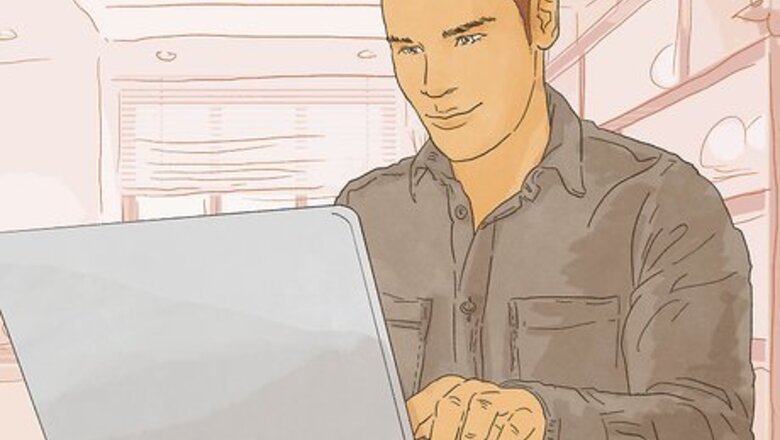
views
Alternatives to “I Hope This Email Finds You Well”

“I hope you’re doing well.” “I hope you’re doing well” means essentially the same as “I hope this email finds you well”; it’s just a bit more modern. And because it’s informal, it also tends to sound a little more sincere and amicable! It’s a simple way to greet someone and wish them well while still being a general phrase that works for most emails. Example: “Hi Jan, I hope you’re doing well. I’m just following up on our conversation last Wednesday. When would you be available to speak?”
“It was great seeing you at…” Use this greeting after you’ve already had a conversation with someone in person and want to continue the discussion over email. Mentioning where you spoke to them (and what you spoke about) can give the recipient some extra context and jog their memory about the interaction. Example: “Good morning! It was great seeing you at the company lunch yesterday and I’d love to keep chatting about some of the ideas we discussed there.” Alternatively, you could say, “We met at…” and list wherever you met them if you’re exchanging emails for the first time. Referencing where you met can help build rapport between you. Example: “Hello! We met at the conference Friday, and I was hoping to continue our discussion when you have the time.”
“Hope you had a great weekend!” This is a generic greeting that’s best to use at the beginning of a work week (since it references the past weekend). Because this type of greeting expresses interest in the recipient’s life outside of work, it also signals to them that you’re open to making some casual small talk. This can help you familiarize yourself with the recipient and build a good working relationship with them! Example: “Hi Alex, I hope you had a great weekend! Hope you got the chance to enjoy some rest and relaxation. Would you be available to meet at 12 pm tomorrow?” There are plenty of different ways to turn an email greeting into small talk; simply use an opener that feels like it’d fit your recipient. Examples include: How are things in Chicago? The weather looks frosty this week!” “I hope your week is off to a great start!” “Happy Friday! Hope you have some fun plans this weekend.” Remember not to try and force the small talk. Just leave a friendly opening, and if they respond, take things from there.
“I know you’re busy, so I’ll be brief.” This phrase is concise and professional while still showing the recipient that you’re trying to be considerate of their time. However, if you tell them you’re going to be brief, remember to actually write a brief email! Limit yourself to the essentials and leave out unnecessary information. Example: “Hi Patty. I know you’re swamped this week, so I’ll be brief. Are you available for a video call with a client next Monday?”
“I’d love an update on…” Use this greeting to check in with a colleague or employee. It’s very straightforward but still polite. By saying “I’d love,” you can keep the tone of your email positive and encouraging while still requesting information from someone. You could also include a deadline for getting the information and, if applicable, how you want it delivered. Example: “Hi, Leah. I’d love an update on how our most recent uploads on YouTube are performing. Could you get those numbers for me by tomorrow afternoon?”
“I appreciate the quick response!” If you’re emailing someone who responded to you very promptly, try using “I appreciate the quick response” as your greeting. With it, you can show the recipient you value the time they spent replying to you and appreciate their promptness. This can be especially important when you’re on a strict deadline. Example: “Hello, Theresa. Thanks for your email; I truly appreciate the quick response! Let’s meet at 9 am tomorrow to finalize these plans.”
“[Contact] recommended that I reach out to you.” When you haven’t met the recipient before but share a mutual contact or colleague, sharing their name at the beginning of your email can help start things off on the right foot and build common ground between you. This can be helpful when emailing about a career opportunity (since a mutual contact may be able to vouch for you). Example: “Hello, Fred. Carol recommended that I reach out to you because your team is looking for a new designer, and I would love to be considered for the job.”
A personalized greeting In place of a generic greeting, you could try a greeting tailored to the person you’re emailing. You might congratulate them on a recent career move or accomplishment or reference some aspect of their work you’re familiar with. Just remember to use a personalized greeting when it relates to the main subject of your email, and don’t bring up anything from the recipient’s personal life. Example: “Hello! I read your essay in a journal last week and was intrigued by the perspective you presented in it….” “Congratulations on successfully funding your company’s latest project! I’m sure it’s exciting to finally turn your plans into a reality.”
No special greeting If you’d rather not worry about finding the perfect greeting for a business email, you don’t necessarily need to include one at all. Some people prefer brief emails that forego the normal pleasantries (like “I hope this email finds you well”). So, beginning your email with a simple “Hi” or “Hello” and then getting straight to the point is actually an effective way to send work emails. Example: “Hi, Lexi. Do you still have last week’s reports? I’d love to get copies for my own files.” This can also show the recipient that you’re trying to be respectful of their time (by being direct and keeping the email brief).
“I Hope This Email Finds You Well” Meaning

The phrase is a formal greeting conveying well-wishes to someone. It’s like saying, “I hope you’re in good health when you get this email,” or simply, “I hope you’re doing all right at the current time.” It’s a variant of an older phrase, “I hope this letter finds you well,” which was common when letters were the main form of communication. Now, in the digital age, “I hope this email finds you well” is much more common. When letters were the main form of communication, it took days (or more) for recipients to get each one—so “I hope this letter finds you well” was intended to express hope that a recipient was doing well since the last exchange.
When to Use Alternative Phrases

Use alternatives to avoid overusing “I hope this email finds you well.” While “I hope this email finds you well” is grammatically correct and still included in some email exchanges, it’s been used so often that it may feel stale or too generic to some people. So, if you’re afraid your email doesn’t feel genuine enough (or you’ve already used “I hope this email finds you well” recently), try using an alternate phrase instead. “I hope this email finds you well” can also sound a little stuffy and old-fashioned. Using a newer, alternate phrase can make your emails feel more modern and personable. Generally, a more personal or sincere opening is better, even when it comes to professional emails because it can build respect and trust with the recipient. However, it’s still perfectly acceptable to use “I hope this email finds you well” from time to time on professional emails, as long as you don’t overuse it.



















Comments
0 comment